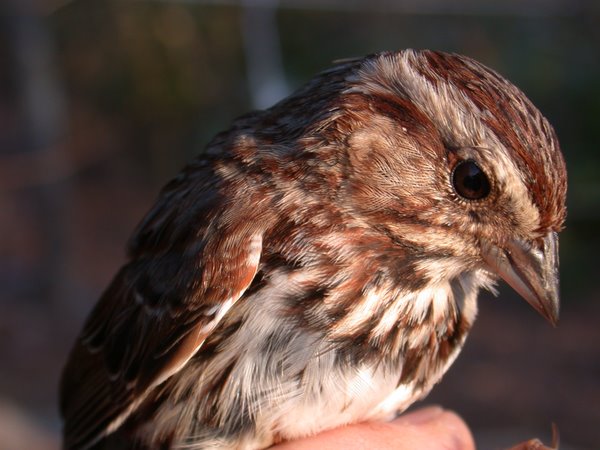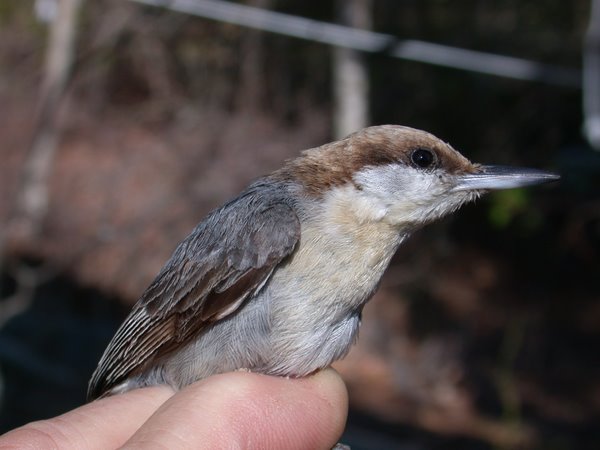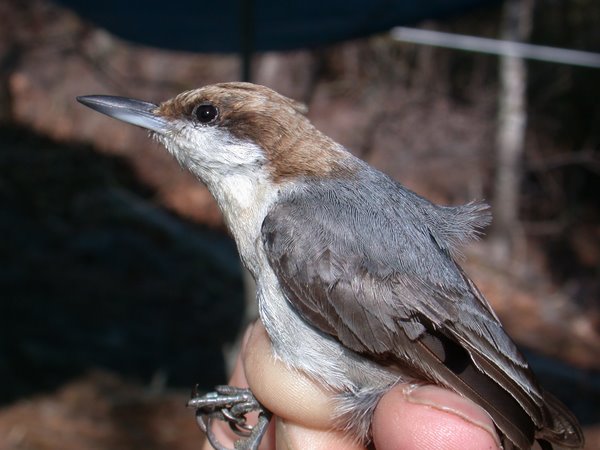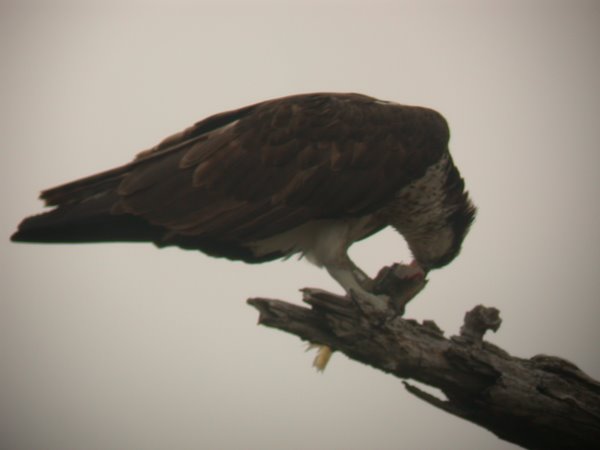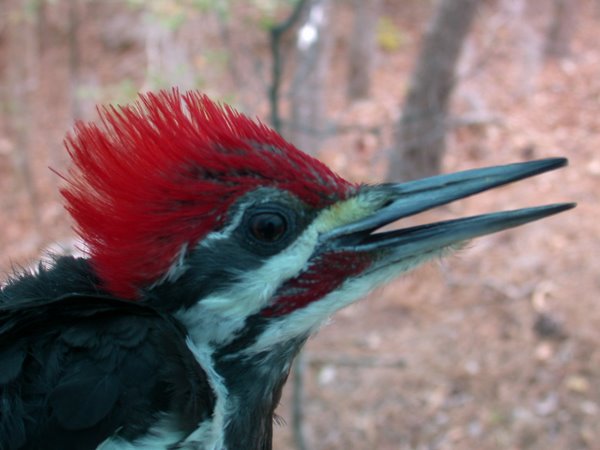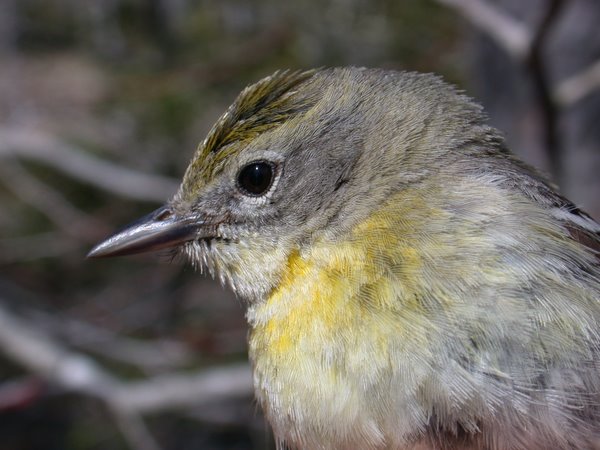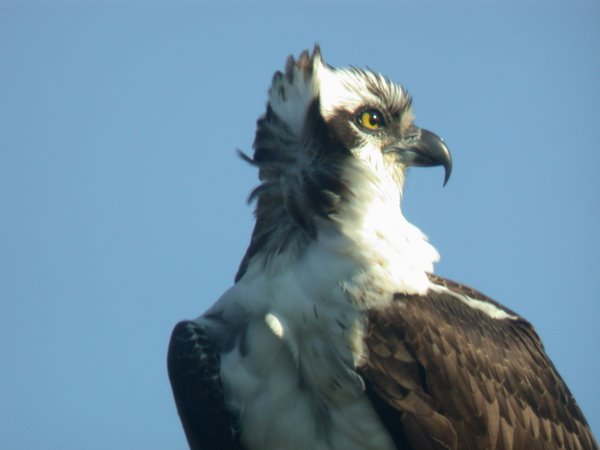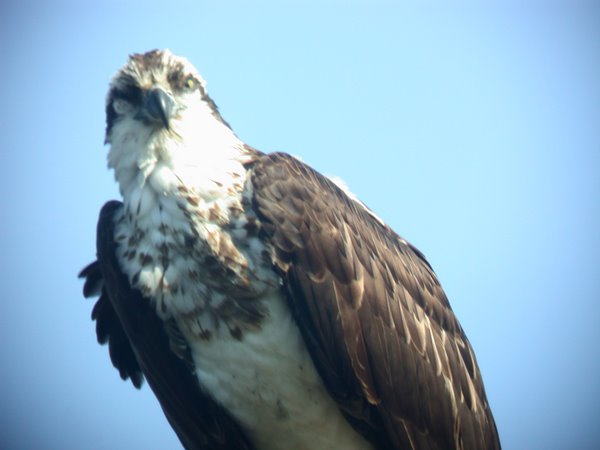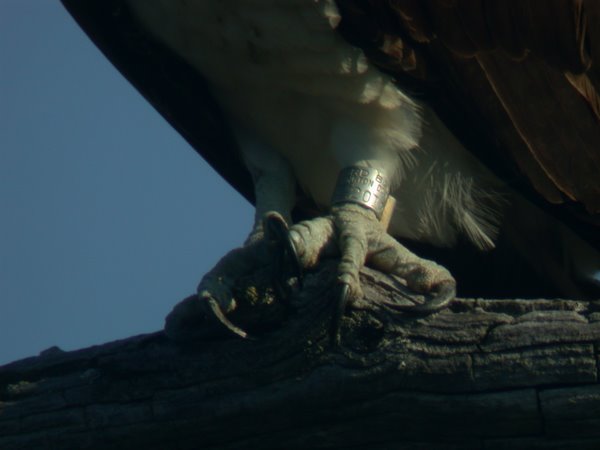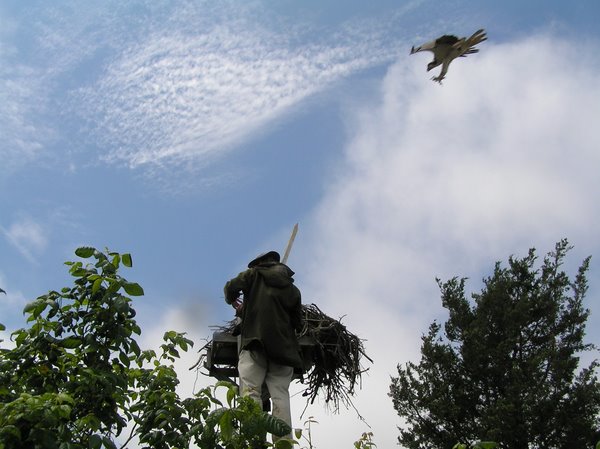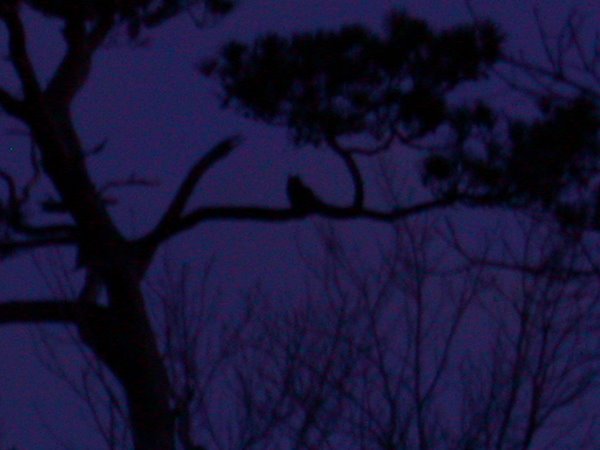 All banders and mist net extractors know that Common Yellowthroats can do remarkable things in a mist net. Simply stated, they can become very tangled and then, more tangled, in a very brief period of time. The Yellowthroat is also one of the two most commonly captured migrants at First Landing each spring; the COYE competes with the Gray Catbird for "top bird". Two hundred or so of each species are marked. Thus, while we were pleased to see this handsome male on March 25th (and he behaved well in the A2 net), trouble is not far away!
All banders and mist net extractors know that Common Yellowthroats can do remarkable things in a mist net. Simply stated, they can become very tangled and then, more tangled, in a very brief period of time. The Yellowthroat is also one of the two most commonly captured migrants at First Landing each spring; the COYE competes with the Gray Catbird for "top bird". Two hundred or so of each species are marked. Thus, while we were pleased to see this handsome male on March 25th (and he behaved well in the A2 net), trouble is not far away!Tuesday, March 30, 2010
Here Comes Trouble...
 All banders and mist net extractors know that Common Yellowthroats can do remarkable things in a mist net. Simply stated, they can become very tangled and then, more tangled, in a very brief period of time. The Yellowthroat is also one of the two most commonly captured migrants at First Landing each spring; the COYE competes with the Gray Catbird for "top bird". Two hundred or so of each species are marked. Thus, while we were pleased to see this handsome male on March 25th (and he behaved well in the A2 net), trouble is not far away!
All banders and mist net extractors know that Common Yellowthroats can do remarkable things in a mist net. Simply stated, they can become very tangled and then, more tangled, in a very brief period of time. The Yellowthroat is also one of the two most commonly captured migrants at First Landing each spring; the COYE competes with the Gray Catbird for "top bird". Two hundred or so of each species are marked. Thus, while we were pleased to see this handsome male on March 25th (and he behaved well in the A2 net), trouble is not far away!A Turtle and A Salamander





Whether it is still,sunny and warm or blustery, sunny and cold or just miserable, March is the slowest month for spring songbirds at First Landing station. Between and during net runs, however, interesting and unusual wildlife can appear--consider March 23 and 24.
The Eastern Mud Turtle (Kinosternon subrubrum subrubrum) pictured above was found inside its carapace (shell) along a dry, sandy stretch of Long Creek Trail as joggers ran past almost stepping on it. This turtle can be identified by its plastron (underside)with its two hinges and the triangular shape of its pectoral scute (plate). see also: http://www.dec.ny.gov/animals/7152.html I picked up the turtle and gave it a lift to a nearby fresh water wetland. The turtle soon emerged from its carapace and crawled off into the mud and water.
While walking in the saltmarsh above the bridge which crosses the tidal creek to White Hill Lake, I found the salamander. Before I picked it up, I thought it was an eel. Upon picking it up, I had no idea what it was, although eel was no longer on the list of possibilities. Mindy Mathenia, CVWO 2010 spring intern, and Sheila Scoville, CVWO board member, each identified the creature as a salamander. Indeed, it is!!
The Two-toed Amphiuma (Amphiuma means) was cold and inactive. Out in the open in the marsh it looked like a meal for the Great Egret which forages there daily. The pictures show the two toes on the small, vestigial limbs which characterize the species. Coastal Virginia is at the northern edge of this Amphiuma's range. see: http://people.wcsu.edu/pinout/herpetology/ameans/index.html and http://amphibiaweb.org/cgi-bin/amphib_query?query_src=aw_lists_alpha_&where-genus=Amphiuma&where-species=means The salamander was released into similar salt marsh habitat nearby the station.
Monday, March 29, 2010
Bahamas Plover in Cape Cod!



The third Bahamas plover re-sighted in the US this spring was seen on Bank Street Beach, Harwich, MA by Susie Gallagher, Town of Dennis plover monitor with MassAudubon for three seasons, and her colleague Ed Nash. [coordinates: N 41.663379° W 070.072140°] The bird was spotted on Saturday, March 27, at 1645. The bird was marked with a black flag on the upper left leg, white band lower left leg; upper right leg unbanded; lower right leg dark blue over orange bands.
This piper was captured, banded and released on South Beach, New Providence, The Bahamas on January 17, 2010. [coordinates: N 25.00693; W 077.33325] The bird was in the first group of birds caught in the Environment Canada Piping Plover Project. It is ~1225 miles from the banding site to the re-sight location.
The top picture above was taken on the Pea Island NWR beachfront just south of Oregon Inlet on December 17, 2005. I spent that winter following Piping Plovers in a Virginia Tech project undertaken by the lab of Dr. Jim Fraser. This is among my favorite images. And it is, in large part, responsible for our ability to capture as many plovers as we did in The Bahamas last winter. The bird with the piper is, of course, a Black-bellied Plover. Pipers always seem to feel safe from outside threats when in the company of the wary "mama" plover. Thus, I had David Rhodes, a noted shorebird carver and conservationist from New Jersey, carve a black-belly for our use this winter. The decoy worked like magic; not only were pipers attracted to the decoy, live black bellies fell in love with her.
UPDATE: Thanks to Ellen Jedrey of MassAudubon for supplying the bottom two photos above, taken by Susie and Ed of the Harwich/Bahamas plover.
Thursday, March 18, 2010
Second Bahamas Plover in South Carolina

Tuesday afternoon, March 16th, on the beach at Kiawah Island, South Carolina the second Piping Plover color-banded in The Bahamas this winter was seen by Aaron Given, a biologist with the Town of Kiawah. This bird was banded on Barbary Beach, Grand Bahama Island, The Bahamas on the late afternoon of January 27, 2010. Kiawah is ~425 air miles from Barbary Beach.
No pictures of the plover on Kiawah are available, but the identification is solid. Another likely ASY, male plover. The picture above is of Barbary Beach, located on the south shore of Grand Bahama. Seven plovers were marked on Barbary on the 27th. The birds foraged on the exposed shelf during low water and roosted on the narrow beach either side of high water.
Monday, March 15, 2010
First Phoebe = Spring!

Spring arrived officially at First Landing State Park in Virginia Beach on the 1145 net run of Thursday, March 11th in net C5. The season's first member of the flycatcher family, Tyrannidae , a second-year Eastern Phoebe, was in the net. As I extracted the bird it snapped its bill together to remind me that it eats flies and to assure me that winter weather is past.
The Picidae Quartet




Last Thursday and Friday, March 10th and 11th, as the temperatures warmed to the upper 50s and into the 60s, woodpeckers were suddenly active about the station. And for the first time this season, woodpeckers found the nets.
The male Pileated pictured was an old friend--of Jethro Runco, the first station bander! This bird, which I aged as an after-third-year bird by virtue of three generations of primary coverts, was banded by Jethro in the spring of 2006 as a third-year bird, meaning that this individual hatched in the Park during the 2004 breeding season. He was fit and trim and weighed 264 grams or 9.25 ounces. (You thought he would weigh more, did you not?) The Yellow-bellied Sapsucker is a handsome second-year male by virtue of the retained, brown, juvenile, body feathers on his breast (among other things). The male Hairy is a fine third-year bird because of retained, worn, inner primary coverts on his wings.
As for the Red-bellied female, she would not hold still for a picture until I agreed to let her grab my thumb (we reached an agreement that she would not peck a hole in it). The resulting image does not reveal how beautiful an after-third-year bird she is.
Friday, March 12, 2010
First Bahamas Piping Plover Re-sighted!!



Today at Little Talbot Island, Duval County, FL, Pat and Doris Leary re-sighted and photographed the first marked Bahamas Piping Plover. The Learys are devoted shorebirders and have re-sighted untold numbers of marked waterbirds in Florida for many years.
The plover was captured and marked on February 17 on a sand flat near South Blanket Sound, Andros Island and was the last of the 57 birds banded in The Bahamas in the 2010 Environment Canada/Bahamas National Trust project. It is ~440 air miles from the Andros capture location to Little Talbot Island.
At Andros the bird was aged as after-second-year and was sexed as likely male. Today's picture shows that the definitive pre-alternate molt has proceeded by the distinct black forehead and breast band, together with the orange base to the bill. The band combination is upper left leg black flag, lower leg black over orange; upper right leg no band, lower left white.
Please be alert for banded Piping Plovers as they migrate to their breeding grounds this spring. They are coming; more will arrive soon.
Tuesday, March 9, 2010
Rusty Blackbird Road Trip



The Rusty Blackbird is declining for reasons which are poorly understood. Given the robust populations of many blackbird species in North America this is surprising to many birders. Sadly it is real. The Rusty Blackbird Working Group was formed in 2005 to discover and understand the cause(s) of the decline. http://nationalzoo.si.edu/ConservationAndScience/MigratoryBirds/Research/Rusty_Blackbird/default.cfm
At present there are research projects in progress throughout the range of the Rusty Blackbird.One of the projects is taking place on study sites in the Carolinas by a University of Georgia/Smithsonian graduate student. Her efforts are directed to understanding aspects of the wintering ecology of the Rusty. During the 2008-09 winter she was able to trap good numbers of Rusties using mist nets. This winter capture rates were discouraging to the point that use of a new method was in order.
Whoosh nets in the back of my truck and the prospect of poor banding conditions in Virginia Beach for a few days, I drove to a study site near Greenville, South Carolina and back between March 3-5. The whoosh net is a modern, bungee-powered net which throws a folded net over birds within the capture area when triggered. The net gains elevation by the use of launch poles. The net is very fast, safe when used properly and can be made in many sizes. The nets used in Greenville were ~38 feet by ~15 feet in coverage. The whoosh pictured above is 19 feet by 14 feet. The net is set and ready to fire.
I have been building and using whoosh nets (usually in concert with my drop nets) for six years. Over that time I have whooshed many targeted species of shorebirds (including many of The Bahamas plovers, see Feb 2010 blogs), Virginia Rails, lure birds for the CVWO Kiptopeke raptor station (Starling and Rock Dove), and some passerines, including 100s of Red-winged Blackbirds. Thus, notwithstanding the almost "mythological" wariness of the Rusty, I had confidence that they could be whooshed if there was a location at which the birds regularly fed AND at which a whoosh could be set.[note: whoosh and drop nets are active nets which only capture birds which the researcher intends to capture, i.e. target species; the mist net is a passive net which catches most birds which encounter the net, target or not.]
By 0630 on the morning of March 5th in a gravel driveway in a surburban neighborhood outside Greenville, we had the whoosh in place. The birds arrived just before 0700, as they had the previous morning when we were still setting the whoosh. Five minutes and one pull of the trigger line later we had eight Rusties to process and release.
The Mixture of Early March Birds
Carolina Wren, Brown Creeper (and remarkable rectices), Fox Sparrow and Blue-headed Vireo represent that which is early March at First Landing: a reliable resident, two predictable winter residents about to begin their migration and a surprise. Such species cause me to arise well before dawn, walk in the cold to the station and open and tend to the nets. That some of these same individuals, year to year, survive and reproduce in the Park or winter, migrate, breed, return and survive in the Park demonstrate the need for undeveloped, open space throughout modern America.
After only five banding days, sixteen birds banded in previous seasons have been recaptured. Among these individuals are Carolina Wren, Myrtle Warbler, Ruby-crowned Kinglet, Northern Cardinal and Eastern Bluebird. Fox Sparrow, Hermit Thrush and Pine Warbler will surely join this group soon.
Bluebirds, Galore!


During my Bahama "absence", Kurt Pederson, good friend and excellent birder, reported large flocks of Eastern Bluebirds on Long Creek Trail this winter. Kurt was correct. Six bluebirds, including a recapture from 2009, found the warming "C" nets as late-morning became noon on March 2d.
Bluebirds are loyal to each other when a member of the flock is in distress. At first, two birds were found in net C3; both were calling. As I took the first out, two more birds became entangled. While I took the now four bluebirds out, three others vocalized and flew back and forth above the net scolding me. The group quickly re-united above the station as I banded and released the four. An hour later two more bluebirds found net C5 and the process repeated itself except that no additional birds were caught. ASY female (top) and male are pictured. The male is the 2009 recapture.
Opening Day Re-run



The very first day of my first spring as bander at FLSP banding station was March 14, 2007. The very first bird banded on the first net run of that first day was a male, after-second-year, Ruby-crowned Kinglet, band 2410-54719.
On the first day of March 2010, the opening day of the sixth CVWO spring season at First Landing, kinglet 2410-54719 was recaptured for the first time since 2007. And the lad looked very fit for a 6.5 gram (1/3 ounce) bird of at least 5 years of age. Sorry, no pictures; it was cold and windy and kinglets are best sent on their way in such conditions.
Some other early observations of note: a. winter-resident Myrtle Warbler numbers are down at the station and elsewhere in the Park; b. while there are Osprey present in the Park and the Osprey nest near the station survived the November northeaster and subsequent storms, the nest and tree is being used much of the time by two Black Vultures; c. Woodcock have been heard and seen towering in the wetland along lower Fox Run; d. dead and living trees all over the Park have fallen or been pruned by the wind and snow of fall 2009 and winter 2010; e. Brown-headed Nuthatches are excavating a total of three cavities along Long Creek and within the station ; f. a partially-leucistic Myrtle Warbler was netted and banded on opening day. Pictures above.
Subscribe to:
Posts (Atom)





